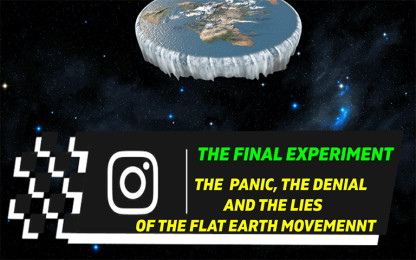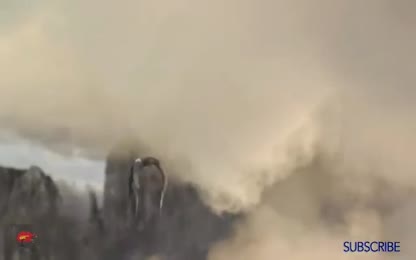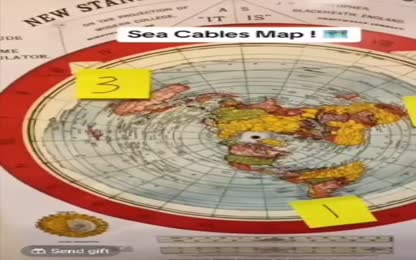Advertisement
Flat Earth Worldwide Cabled Internet ~ Satellites Don’t Exist
Flat Earth Worldwide Cabled Internet ~ Satellites Don’t Exist
- Category: Flat Earth Theory/Not Spinning,Satellites / Space / Planets,Research /Investigation/Report,Red Pill/Free-ThinkingAttitude
- Duration: 07:04
- Date: 2022-02-12 18:24:34
- Tags: no-tag
4 Comments
Video Transcript:
On March 30, of 2016, 10 African countries were taken completely offline for two full days after just one cable was inadvertently cut by a lone fishing trawler. You may be surprised to learn just how dependent the world is on underwater cable infrastructure for internet access. Although many of us consistently use wireless devices, the most critical piece of the internet is that network of undersea submarine cables that provide international connections to servers abroad and connect continents and islands to the worldwide web. The specific cable cut in the African internet incident was the African coast to Europe cable or better known as the Ace Cable. Commissioned in 2012, this cable stretches 10,500 miles from France to South Africa to provide internet connections to nearly all of Western coastal Africa, including Mauritania, Senegal, Gambia, Sierra Leone, Liberia, Guinea, Molly, Niger, Ivory Coast, Ghana, Benin, Nigeria, Cameroon, Equatorial Guinea, Gebon, the Democratic Republic of Congo, Angola, Nambia, and a country of South Africa. Many of these countries rely solely on the Ace Cable to stay connected to the world and without it ceased to have a means of reliable communication. This begs the greater question as to just how many of these cables exist and how dependent is the world-wide web on this underwater infrastructure. Today, over 99% of all international internet traffic is routed through a network of over 420 submarine cables in service, stretching over 700,000 miles around the world. This is equivalent to wrapping a single cable over 28 times around the Earth's equator. This vast network of cables provides the underlying infrastructure to the internet's high bandwidth highways. These cables use optical fiber to provide average data transmission rates of 35 terabits per second, which is crazy because just over five years ago, the average data rate was only 9 terabits per second, which equates to nearly a four times increase. Some of the newer and most cutting edge cables, such as the Maria cable, which in Spanish stands for high tide, are even faster. This cable, which is owned and funded by Microsoft and Facebook, connects Virginia Beach, Virginia in the United States to Bilbao, Spain, and is capable of data transmission rates of up to 160 terabits per second. This is the equivalent of streaming 71 million HD videos at the same time, and it is 16 million times faster than the average home internet connection. The makeup and production of these cables is also extremely important. Submarine cables are typically thick and size, with most being 3 to 4 inches in diameter, while the actual wire the internet runs across is typically no thicker than a human hair. This is because the majority of the cables purpose is strictly for protection, with roughly 100 cable faults found every year, repair of existing cables is an absolute necessity. Of these faults, 38% of the faults occur because of fishing activities, 25% from anchorage issues, and just 6% of faults are derived from actual cable failures. Most cables will last an average of 25 years, however many are retired early because the bandwidth capacities provided become too slow, and therefore are obsolete. These submarine cables must comply with strict electrical standards in order to be installed underwater. At depths of as much as 8,000 meters to traverse the mid-Atlantic ridge, cables must be capable of handling the extreme pressures that these environments require. As an example, the pressure at these depths is the equivalent of trying to hold up an entire car with just your thumb. Additionally, the cables must account for rocky seabeds, marine animals, tsunamis, volcanoes, and even the occasional shark. As a result of these threats, the majority of the cables make up is just for protection. To break it down further, the cable starts with the optical fiber itself, which is the means by which the data is transmitted. These fibers are then coated with petroleum jelly for lubrication and to keep the fiber firmly in place within the larger cable assembly. The next layer is a copper tubing which is used to not only provide the next layer protection, but is also used to power the cable. Yes, this is an active cable. Due to the extreme lengths of underwater internet cables, the light inside the optical fibers must be boosted every 50 or so miles to amplify the signal and prevent data loss. After these core layers, the remaining layers are strictly for protection and include the polycarbonate layer, the aluminum water barrier, thick stranded steel wires, a layer of mylar tape, and tar coating for ruggedness and protection. The process of laying the cable is equally as important as the production of the cable. The laying of the cables perform by a special trollar ship that is capable of carrying giant spools of internet cables and unreeling them as it passes from shore to shore. The first step to laying the cable requires an extensive survey be performed at the sea floor to map the route for which the cable will be laid. After being loaded onto a ship's hole in large spools, the reels will be unwound as the ship travels along the map route. A sea plow is towed along the back of the ship as well to aid in bearing the cable a few inches below the surface for added protection. At the end of the installation process, extensive testing and inspection of the cable has performed before the cable is put into service. Now you may be wondering when this fast network of undersea cables began. Surprisingly enough, the first undersea cable was laid over 177 years ago all the way back in 1842. In Samuel Morse, the developer of Morse code and commercial telegraphy decided to submerge a cable insulated with TARD HEM and Indie Rubber in the waters of New York Harbor to run a telegraph through it. After a successful experiment, it wasn't long after this in 1858 when the first transatlantic telegraph cable was laid between the United States and Great Britain. This connection with endpoints and new foundland in Ireland allowed communication between the transatlantic shipping companies to go from matter of weeks to just a matter of minutes. The demand for internet capacity is only set to increase as new consumers and industrial devices turn online over the next few decades. Most predictions place half of the world's population as internet users by next year in 2020. Historically, bandwidth capacity, connectivity, and low latency have all been the drivers behind the construction of undersea cables. By the year 2022, there are 35 new cables slated to be turned online in order to handle the increased traffic demands from some of the largest companies such as Alphabet, Microsoft, Amazon, Facebook, and Apple, all of which combined are responsible for nearly 70% of all internet traffic. Although there are opportunities for satellites to serve more disadvantaged areas of the world where physical links are not practical, possible, undersea cables will continue to remain the backbone of the internet for decades to come. Thanks for taking the time to watch this video. What ways do you expect the internet's infrastructure will evolve over the next few decades? Leave your comments below and be sure to share like and subscribe if you've not already done so.










 Donate
Donate







